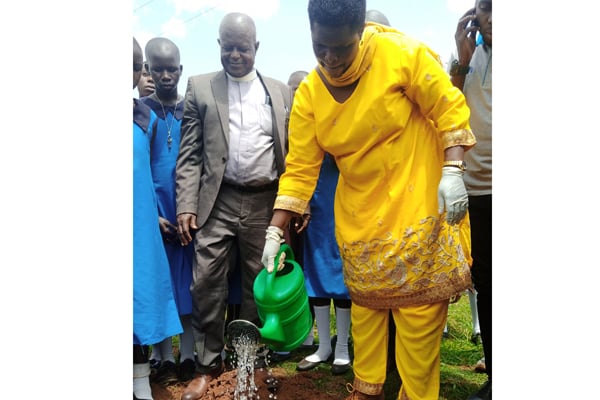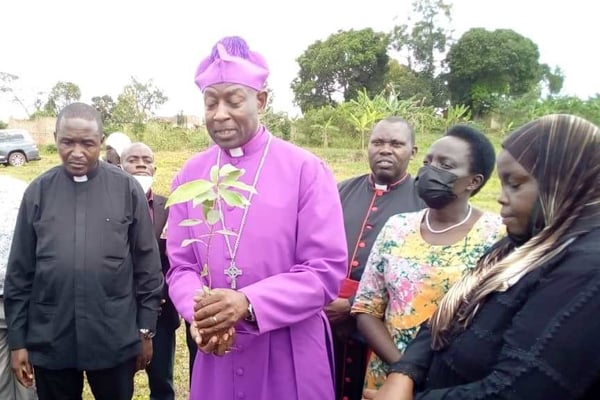Every Ugandan to plant 11 trees to restore forest cover

Kwania deputy Resident District commissioner, Ms Proscovia Acham (right), during a tree planting exercise at Aduku Boarding Primary School on May 20. Every Ugandan is required to plant at least 11 trees for the country to restore its forest cover.
PHOTO / BILL OKETCH
What you need to know:
- According to Mr Patrick Hans Igulot, the northern Uganda regional forestry officer at the Ministry of Water and Environment, the country has about 12.4 per cent of forest cover down from 24 per cent in 1990.
The Ministry of Water and Environment has revealed that every Ugandan is required to plant at least 11 trees for the country to restore its forest cover.
According to Mr Patrick Hans Igulot, the northern Uganda regional forestry officer at the Ministry of Water and Environment, the country has about 12.4 per cent of forest cover down from 24 per cent in 1990.
Speaking at the launch of the running out of trees campaign at Aduku Boarding Primary School in Kwania District on Friday, Mr Igulot said climate change is real and that it is attributed to loss of forest cover.
“As we speak, we are supposed to be experiencing rains but even here there is no rain. The place is dry!” Mr Igulot said.
He added: “ We have cut a lot of trees and we want to put them back. So, the reason we are here today is to call upon every Ugandan to join hands and we get back our forest cover to the levels of 1990 by 2030.”
During the 2014 Climate Change Summit, Uganda pledged to restore 2.5 million hectares of degraded land by 2030 (the Bonn Challenge).
Accordingly, the government launched the running out of trees campaign in 2019, appealing to every citizen to continue planting at least one tree every year.
With support from Uganda’s population, the government targets to have 40 million trees planted annually.
According to the National Environment Management Authority, in 1990, Uganda had over five million hectares of forest cover but in 2005 only 3.5 million hectares (8.6 million acres) had remained. Mr Jimmy Okweny, the Kwania environment officer, said more trees are being cut compared to those being planted in the area.
“Over 15 percent of our tree cover is lost. The recent floods that affected areas around Lake Kwania are attributed to many factors including of deforestation,” he said.
Mr Okweny siad in the past, trees used to grow naturally but things have changed as people have to plant them.
“So, I emphasize that the government should support us by providing more funds and technical advice so that we are able to green our environment by planting trees,” he said.
The Kwania deputy chief administrative officer, Mr Bernard Olupot, said they intend to put in place an ordinance to reinforce the National Forestry and Tree Planting Act of 2003 to make tree planting compulsory at household level.
Rev Canon Vincent Ogwang, the dean of St Peter’s Cathedral-Aduku, said: “People who are educated in a way may be part of the system whose mindsets are adamant to tree planting campaign, but I want to say can we all wake up, plant trees for the good of ourselves and the future.”
Ms Proscovia Acham, the Kwania deputy resident district commissioner, said communities have destroyed wetlands in the area for cultivation.
“In fact, we don’t have any wetland now. People have gone to extent of cultivating in the night. You can imagine at 2am somebody is in the garden. Are you not becoming a witch?” she said.
“But we want to promise that whatever has been planted in the wetlands is going to be slashed down, as simple as that,” Ms Acham warned.
ISSUE
The country’s surging charcoal industry is destroying forests and biodiversity, and if deforestation continues at the present rate, Uganda will lose all its forest by 2050. According to United Nations data, as of 2018, only a little over 42 per cent of Ugandans had access to electricity — many were too poor to afford it. Statistics add that between 2016 and 2017, 90 percent of all households burned wood fuel for cooking.




